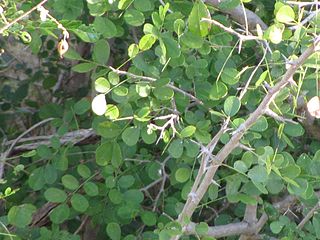
Cobra is the common name of various snakes, most of which belong to the genus Naja.
Cypress is a common name for various coniferous trees or shrubs of northern temperate regions that belong to the family Cupressaceae. The word cypress is derived from Old French cipres, which was imported from Latin cypressus, the latinisation of the Greek κυπάρισσος (kyparissos). Cypress trees are a large classification of conifers, encompassing the trees and shrubs from the cypress family (Cupressaceae) and many others with the word cypress in their common name. Many cypress trees have needle-like, evergreen foliage and acorn-like seed cones.
Kulu or KULU may refer to:

Dalbergia melanoxylon in french Granadille d'Afrique is a flowering plant in the family Fabaceae, native to seasonally dry regions of Africa from Senegal east to Eritrea, to southern regions of Tanzania to Mozambique and south to the north-eastern parts of South Africa. The tree is an important timber species in its native areas; it is used in the manufacture of musical instruments, sculptures vinyago in Swahili language and fine furnitures. Populations and genomic resources for genetic biodiversity maintenance in parts of its native range are threatened by overharvesting due to poor or absent conservation planning and by the species' low germination rates.

The dingiso, also known as the bondegezou, is an endangered, long-tailed marsupial found only in mountain forests on the west of the island of New Guinea. It is a species of tree-kangaroo, which are mammals native to Australia and New Guinea that feed on leaves or other plant matter. It belongs to the macropodid family (Macropodidae) with kangaroos, and carries its young in a pouch like most other marsupials. Though sacred to the local Moni people, it is still threatened by hunting and habitat loss.

The Santa Cruz cypress is a species of North American tree within the Cypress family. The species is endemic to the Santa Cruz Mountains within the Santa Cruz and San Mateo counties of west-central California. The U.S. Fish and Wildlife Service listed the species on the Endangered Species Act in 1987 due to increasing threats from habitat loss and disruption of natural forest fire regimes. In 2016, the conservation status of the Santa Cruz cypress changed to Threatened. The cited reasoning was a decrease in threats against their habitat.

Botanic Gardens Conservation International (BGCI) is a plant conservation charity based in Kew, Surrey, England. It is a membership organisation, working with 800 botanic gardens in 118 countries, whose combined work forms the world's largest plant conservation network.

Pericopsis elata is a species of flowering plant in the family Fabaceae and is known by the common names African teak, afromosia, afrormosia, kokrodua and assamela.

The Aldabra flying fox is a species of megabat in the genus Pteropus. It is endemic to the Aldabra Atoll in the Seychelles, like Chaerephon pusilla, though the latter may be the same species as the little free-tailed bat.

The Madagascan flying fox, Madagascar flying-fox, or Madagascar fruit bat is a species of megabat in the genus Pteropus. It is endemic to Madagascar. Its natural habitats are diverse, and include moist lowland forests, dry forests, succulent woodlands, and spiny thickets, and mangroves. It eats figs and other fruits, flowers, and leaves. It is threatened by habitat loss.

Distemonanthus is a genus of flowering plants in the family Fabaceae. It belongs to the subfamily Dialioideae. It contains a single species, Distemonanthus benthamianus, a deciduous tree, which occurs widely but sparsely in the forest regions of Tropical West and Central Africa; it is sometimes confused with Pericopsis laxiflora due to similar morphological features.
Horagolla National Park is one of the latest national parks in Sri Lanka. It is so called because of an abundance of Dipterocarpus zeylanicus (hora) trees. The area was originally declared as a wildlife sanctuary on 5 September 1973 due to its rich biodiversity. Later on 24 June 2004, Horagolla was elevated to national park status. Horagolla is the only urban park in the Western Province of Sri Lanka. The park is situated close to Horagolla Walauwa, the home of the Bandaranaike family. The park is situated some 40 kilometres (25 mi) from Colombo.
Eugenia mooniana, is a species of plant in the family Myrtaceae which is native to Western Ghats of India and Sri Lanka.
Mount Chiperone is a mountain in northern Mozambique.
The Guineo-Congolian region is a biogeographical region in Africa straddling the Equator and stretching from the Atlantic Ocean through the Congo Basin to the Congo / Nile divide in Rwanda and Burundi. Formerly, this region was largely covered in rain forest, on both well-drained sites and in swamp forests, but little undisturbed primary forest now remains, having been replaced in many areas by savanna and secondary-growth forest.

Okoubaka aubrevillei is a rare tropical tree species distributed throughout tropical rainforests of West and Central Africa that is thought to be the largest known parasitic plant.
Yangambi Biosphere Reserve is a protected area in the Democratic Republic of the Congo. It is located in Tshopo province.

Pericopsis laxiflora is a woody deciduous shrub or tree within the Fabaceae family. Sold commercially as satin wood, it is known in some regions as Kulu Kulu, among the Hausa speaking people, it is called Makarfo, the Yorubas call it Ayan and the Igbos call it Abua-Ocha. It is one of three species in the genus Pericopsis genus that occurs in Africa.












